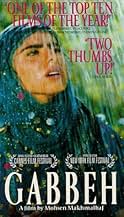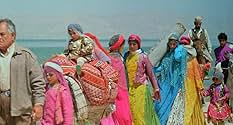CALIFICACIÓN DE IMDb
6.9/10
3.8 k
TU CALIFICACIÓN
Agrega una trama en tu idiomaWhen an old couple washes their gabbeh - a type of Persian rug - a young woman magically appears and tells them her life story.When an old couple washes their gabbeh - a type of Persian rug - a young woman magically appears and tells them her life story.When an old couple washes their gabbeh - a type of Persian rug - a young woman magically appears and tells them her life story.
- Dirección
- Guionista
- Elenco
- Premios
- 5 premios ganados y 5 nominaciones en total
- Dirección
- Guionista
- Todo el elenco y el equipo
- Producción, taquilla y más en IMDbPro
Opiniones destacadas
Is it racist to insist that this is the most beautiful film I have ever seen? I say racist, because much of what is 'merely' beautiful to me is part of a rich symbolic texture I couldn't always get; concentrating on aesthetics may seem to rob a film of its political force. That it has such force is proven by its being banned in its country of origin - Makhmalbaf's hiding behind allegory cannot disguise his impassioned analysis of poverty, the oppressiveness of tradition or the loneliness of women in a patriarchal society. This is a film full of nature's marvel, yet shows how 'nature' is often used to justify social repression - as the teacher's lesson demonstrates, if the creation of the gabbeh (an ornamental, narrative carpet) is art in nature's image, than nature (and the rules it inspires) is merely a recreation of ours.
(1996) Gabbeh
(In Iran/ Persian with English subtitles)
FANTASY/ DRAMA
Edited, written and directed by Mohsen Makhmalbaf that consists of a similar idea to films as "How To Make An American Quilt" and "Little Big Man" or "A Man Called Horse" where it has a blanket revealing a story or a folklore tale or a myth. And in order for anyone to understand this demands the right frame of mind, and to be familiar with Iranian rituals and customs for it's completely plot less, using surrealism in some scenes and then using imagery of landscapes on others. The word "Gabbeh" is a name of an interwoven blanket with pictures, telling a story in Iranian fashion in which the beginning is boring as I'm totally oblivious about Iranian culture but gets more interesting as the film progresses.
Edited, written and directed by Mohsen Makhmalbaf that consists of a similar idea to films as "How To Make An American Quilt" and "Little Big Man" or "A Man Called Horse" where it has a blanket revealing a story or a folklore tale or a myth. And in order for anyone to understand this demands the right frame of mind, and to be familiar with Iranian rituals and customs for it's completely plot less, using surrealism in some scenes and then using imagery of landscapes on others. The word "Gabbeh" is a name of an interwoven blanket with pictures, telling a story in Iranian fashion in which the beginning is boring as I'm totally oblivious about Iranian culture but gets more interesting as the film progresses.
This visually stunning film tells the story of an old couple's gabbeh-a finely crafted Persian carpet. One day when they go to a nearby spring to wash the carpet, an attractive young woman appears suddenly and mysteriously-she is the apotheosis of the people whose tale is told in the carpet's woof and warp.
The film is a surrealistic folk tale. As she helps the old woman wash the carpet, the young woman (the spirit of the carpet) begins the tale of her life, which becomes the film's story. The film's charm lies in the magical use of color and water to tell a story. Young girls are everywhere in native dresses that complement the picturesque scenery with as many dabs of color as a French impressionist painting. The filmmaker here is an artist, adept at sunsets, drifting cotton-white clouds on a pristine blue canvas. Pastels, ultramarines, burnt siennas, ochres-there is a sensuous joy in the very colors of the earth and sky.
The world of the film is a kaleidoscope of color. Exotic birds appear from nowhere like bursts of sunset. Young women dress in native Iranian costumes of reds, golds, blues, and greens. And through it all, the sounds of flowing water, like little bells or delicate wind chimes, is given a palpable presence.
The Persian carpet, no longer mute, beguiles the viewer with its simple, haunting tale of people and places at once so ancient and new. The wolf-like howls of a young woman's lover merge with the sound of the water as it rills and flows over stones, pebbles, and sand. The water is itself a comment on the people whose lives are lived within its boundaries. The magical and surrealistic elements of the peasant girl's story weave themselves into a fairy-tale. What enchantment there is in a young woman's quest for love and continuity. The very air is rich with the colors, sights, and sounds-the spices and incense of the Near East.
The film is a surrealistic folk tale. As she helps the old woman wash the carpet, the young woman (the spirit of the carpet) begins the tale of her life, which becomes the film's story. The film's charm lies in the magical use of color and water to tell a story. Young girls are everywhere in native dresses that complement the picturesque scenery with as many dabs of color as a French impressionist painting. The filmmaker here is an artist, adept at sunsets, drifting cotton-white clouds on a pristine blue canvas. Pastels, ultramarines, burnt siennas, ochres-there is a sensuous joy in the very colors of the earth and sky.
The world of the film is a kaleidoscope of color. Exotic birds appear from nowhere like bursts of sunset. Young women dress in native Iranian costumes of reds, golds, blues, and greens. And through it all, the sounds of flowing water, like little bells or delicate wind chimes, is given a palpable presence.
The Persian carpet, no longer mute, beguiles the viewer with its simple, haunting tale of people and places at once so ancient and new. The wolf-like howls of a young woman's lover merge with the sound of the water as it rills and flows over stones, pebbles, and sand. The water is itself a comment on the people whose lives are lived within its boundaries. The magical and surrealistic elements of the peasant girl's story weave themselves into a fairy-tale. What enchantment there is in a young woman's quest for love and continuity. The very air is rich with the colors, sights, and sounds-the spices and incense of the Near East.
GABBEH is so magical, colorful and involving that it makes me feel like a child listening a "once upon a time" story. The film is superb. Every scene is pure magic. At the end, you feel like you were dreaming: a beautiful shining dream. Don't worry if you want to see again and again again... See it now - if it's possible. 10/10
Mohsen Makhmalbaf has done it with every movie he's made. Gabbeh is a major film where beauty is presented in the original language of filmmaking: music -not only the "human music", rather than the music from the sounds of nature- and images -"life is color", "love is color" is said just twice in the film, but the entire film is exactly that: life and love, which is just color-. The expressiveness of the landscape, the Iranian women's clothing and fabric are the main characters of the film. Because masterpieces do not need words, high-tech, major budgets, nor even a plot. 60 minutes of beauty, that's Gabbeh.
¿Sabías que…?
- TriviaIran's submission for 70th Academy Awards.
- ConexionesFeatured in Stardust Stricken - Mohsen Makhmalbaf: A Portrait (1996)
Selecciones populares
Inicia sesión para calificar y agrega a la lista de videos para obtener recomendaciones personalizadas
- How long is Gabbeh?Con tecnología de Alexa
Detalles
Taquilla
- Total en EE. UU. y Canadá
- USD 532,629
- Total a nivel mundial
- USD 532,629
Contribuir a esta página
Sugiere una edición o agrega el contenido que falta

Principales brechas de datos
By what name was Gabbeh (1996) officially released in Canada in English?
Responda




















